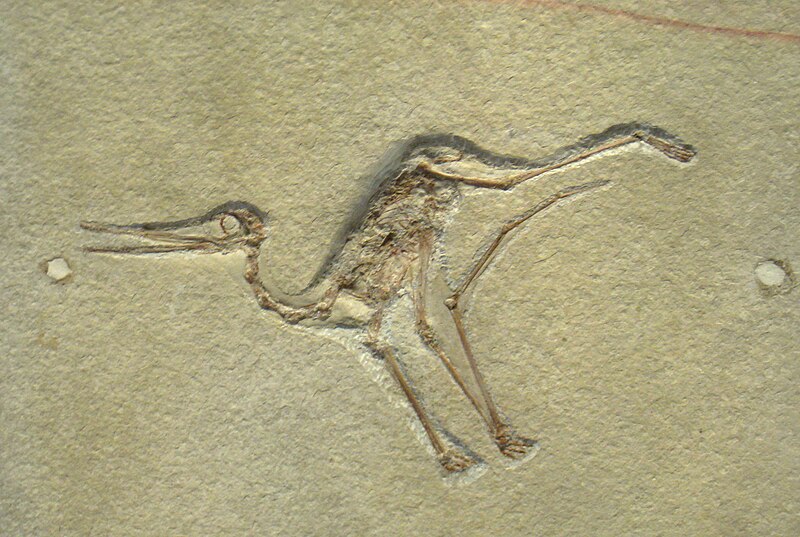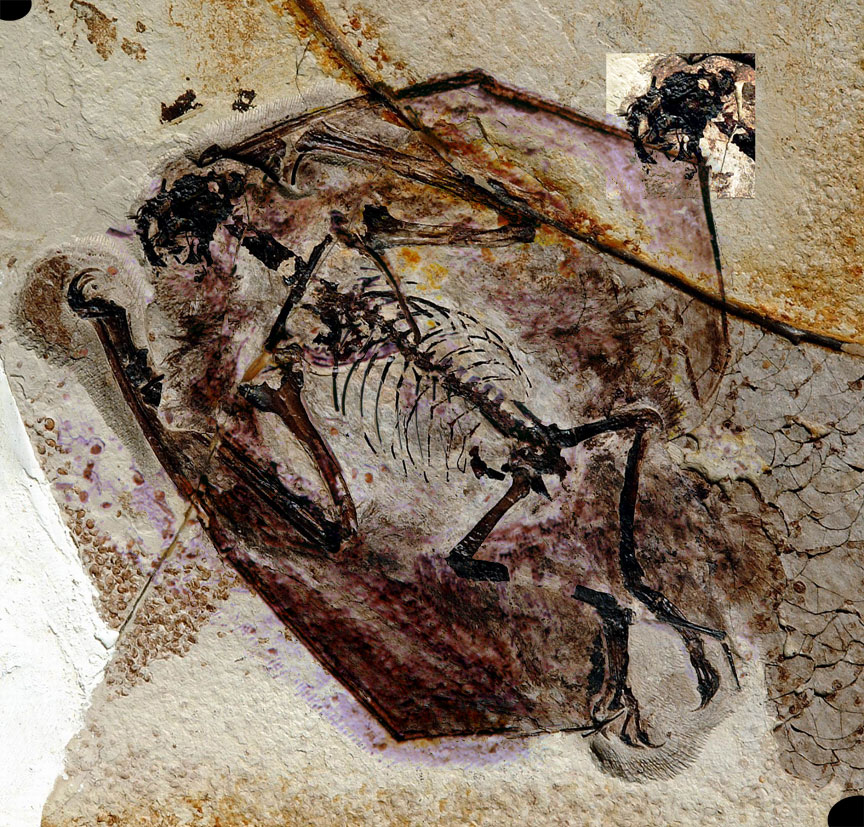[Recent Entries][Archive][Friends][User Info]
May 22nd, 2012
| May 22nd, 2012 | |
|---|---|
| 07:02 pm [industrialterro] [Link] |
Germanodactylus Germanodactylus ("German finger") is a genus of dsungaripteroid pterodactyloid pterosaur from Late Jurassic-age rocks of Germany, including the Solnhofen limestone. Its specimens were long thought to pertain to Pterodactylus. Its head crest is a distinctive feature. Germanodactylus is described as being "raven-sized" in weight. G. cristatus had a 0.98 wingspan (3.2 ft) and a 13 centimeter long (5.1 in) skull, while G. rhamphastinus was somewhat larger, with a 1.08 meter wingspan (3.5 ft) and a skull 21 centimeters long (8.3 in). Germanodactylus is known for its head crest, which had a bony portion (a low ridge running up the midline of the skull) and a soft-tissue portion that more than doubled its height. The bony part does not go as far up the head in G. cristatus as in G. rhamphastinus. The soft-tissue portion was not known early on, being first described in 2002 by S. Christopher Bennett. It was probably composed of cornified epidermis. Germanodactylus is the first genus for which a soft-tissue component of the crest is known, but similar structures were probably widespread among pterosaurs. This genus is unspecialized compared to the pterosaurs of the Cretaceous, and has had varying placements in Pterosauria. Yang Zhongjian, who named the genus, gave it its own family Germanodactylidae. Bennett included the genus in the family Pterodactylidae, and Alexander W.A. Kellner found it to be related to Pterodactylus in his 2003 phylogenetic analysis. David M. Unwin, on the other hand, preferred to consider it a basal dsungaripteroid, a group that evolved into dedicated shellfish-eaters. G. cristatus is based on specimen BSP 1892.IV.1, from the Solnhofen limestone of Eichstätt, Germany. It was originally described by Plieninger in 1901 as a specimen of Pterodactylus kochi, and was given its current specific name by Carl Wiman in 1925, meaning "crested" in Latin. Yang Zhongjian determined that it deserved its own genus in 1964. Second species G. ramphastinus (in 1858 accidentally revised to rhamphastinus by Christian Erich Hermann von Meyer) was named as a distinct species long before G. cristatus, described by Johann Andreas Wagner in 1851 as a species of the now deprecated genus Ornithocephalus. The specific name refers to the toucan, ramphastinos in Greek. It is based on specimen BSP AS.I.745, a skeleton from the slightly younger Mörnsheimer Limestone of Daiting, Germany. Peter Wellnhofer added it to Germanodactylus in 1970, although Maisch and his coauthors have suggested that it deserves its own genus, "Daitingopterus" David M. Unwin has also referred miscellaneous limb bones and vertebrae from the somewhat older Kimmeridge Clay of Dorset, England to the genus; these finds at the time marked the earliest appearance of short-tailed pterosaurs in the fossil record. Bennett suggested in 1996 that Germanodactylus represented adults of Pterodactylus, but this has been rejected by further studies, including his own. Bennett's 2006 reappraisal of Germanodactylus found both species to be valid and included within the genus, with G. cristatus known from four specimens including two juveniles, and G. rhamphastinus from two specimens. The genus differs from other pterosaurs by a combination of characteristics including a sharply pointed jaw tip, 4-5 premaxillary teeth and 8-12 maxillary teeth per side of the upper jaw, robust maxillary teeth that, unlike in Pterodactylus, are not reduced in size farther from the tip of the jaw, a naso-antorbital fenestra twice the length of the eye socket, and various proportional differences. G. cristatus differs from G. rhampastinus by having no teeth in the tip of the jaw and fewer teeth (~13 in each side of the upper jaw and ~12 in the lower versus 16 upper and 15 lower on each side for G. rhamphastinus). Dsungaripteroidea is a group of pterosaurs within the suborder Pterodactyloidea. The earliest known fossils attributed to this group are from the Kimmeridgian-age Upper Jurassic Argiles d'Octeville Formation of France, dated to around 155 million years ago, and belonging to the species Normannognathus wellnhoferi. The last known dsungaripteroid species is Lonchognathosaurus acutirostris, from the Albian-age Lower Cretaceous Lianmuqin Formation of Xinjiang, China, about 112 million years ago.
Ископаемые останки (1, 2, 3, 4, 5):
Tags: Вымершие рептилии, Юра, авеметатарзалии, аждархойды, архозавроморфы, архозавры, джунгариптероиды, диапсиды, монофенестраты, орнитохейройды, птеродактили, птерозавры |
| Time | Event |
| 07:26 pm [industrialterro] [Link] |
Gnathosaurus Gnathosaurus (meaning 'jaw lizard') is a genus of ctenochasmatid pterosaur known from a single species, G. subulatus, described in 1833. This pterosaur had an estimated wingspan of about 1.7 meters. The slender, 28-cm-long skull had up to 130 needle-like teeth arranged laterally around the spoon-shaped tip. Fragments of Gnathosaurus jaw were first discovered in 1832 in the Solnhofen limestones of Southern Germany but were mistaken for a piece of teleosaurid crocodile jaw, hence the synonym Crocodylus multidens. Only when a complete skull was found in 1951 this animal was found to have been a pterosaur. The teeth arranged in a spoon shape may have been used to strain water for small animals, although this is conjectural. Several paleontologists, such as Christopher Bennett, have suggested that a purported tiny Pterodactylus species, P. micronyx, is likely a juvenile of Gnathosaurus subulatus. Ctenochasmatoidea is a group of pterosaurs within the suborder Pterodactyloidea. The earliest known ctenochasmatoid remains have been found in the Stonesfield Slate formation (UK), which dates to the Bathonian stage of the Middle Jurassic, dated to about 166 million years ago.
Tags: Вымершие рептилии, Юра, авеметатарзалии, архозавроморфы, архозавры, диапсиды, ктенохазматоидеи, монофенестраты, птеродактили, птерозавры |
| Time | Event |
| 07:39 pm [industrialterro] [Link] |
Jeholopterus Jeholopterus was a small anurognathid pterosaur from the Daohugou Beds of northeastern China (of uncertain age, probably Middle or Late Jurassic), between 168 and 152 million years ago), preserved with hair and skin remains. The type species is based on holotype IVPP V12705, a nearly complete specimen from the Daohugou beds of Ningcheng County in the Neimongol (Inner Mongolia) Autonomous Region of China. The specimen is crushed into a slab and counterslab pair, so that parts of the specimen are preserved on one side of a split stone and some on the other. This includes exquisite preservation of carbonized skin fibers and, arguably, "hair" or "protofeathers." The fibers are preserved around the body of the specimen in a "halo." Wing tissue is preserved, though its extent is debatable, including the exact points of attachment to the legs (or if it attached to the legs at all). In 2009 Alexander Kellner published a study reporting the presence of three layers of fibres in the wing, allowing the animal to precisely adapt the wing profile. As an anurognathid, Jeholopterus shows the skull form typical for this group, being wider than it was long (28 mm), with a very broad mouth. Most teeth are small and peg-like, but some are longer and recurved. The neck was short with seven or eight cervical vertebrae. Twelve or thirteen dorsal vertebrae are present and three sacrals. There are five pairs of belly ribs. The tail vertebrae have not been preserved. The describers argue that Jeholopterus had a short tail, a feature seen in other anurognathids but unusual for "rhamphorhynchoid" (i.e. basal) pterosaurs that typically have a long tail. Wang et al. cited the presence of a fringe of hair in the region of the tail to infer the presence of a short tail. However, a subsequent study by Dalla Vecchia argued that gleaning any information about the tail is impossible, given that the tail is "totally absent" in the fossil. The wing bones are robust. The metacarpals are very short. A short pteroid, supporting a propatagium, is pointing towards the body. The hand claws are long and curved. The wings of Jeholopterus show evidence that they attached to the ankle, according to Wang et al.. They are relatively elongated with a wingspan of ninety centimetres. The legs are short but robust. The toes bear well-developed curved claws, but these are not as long as the hand claws. The fifth toe is elongated, according to the authors supporting a membrane between the legs, the uropatagium. Jeholopterus was by the authors assigned to the Anurognathidae. In 2003 a cladistic analysis by Kellner found it to be a member, together with Dendrorhynchoides and Batrachognathus of an anurognathid clade Asiaticognathidae. An analysis by Lü Junchang in 2006 resolved its position as being the sister taxon of Batrachognathus. Далее идёт пятиминутка острого, запущенного хумора: Though he never examined the fossil himself, advertising artist David Peters has popularized his idiosyncratic opinions about Jeholopterus and other pterosaurs widely on the internet. In general he finds and illustrates hosts of ornamental features and even multiple embryos although no other researchers have ever confirmed his findings. By manipulating downloaded images of Jeholopterus in the computer art program Photoshop, David Peters (2003) reported that he discovered an unusual suite of soft-tissue remains, including a horse-like tail Peters speculated may have been used as a fly sweeper/distractor, as well as a long fly lure (similar to that of the anglerfish) protruding from the head, and a fin or series of fins along the back. Peters also reported that he had found "rattlesnake-like fangs", and these, along with what he described as a rattle-snake-like mandible, buttressed palate, "surgically-sharp" unguals, robust limbs and other characters suggested that Jeholopterus was a vampire pterosaur adapted to plunging fangs into tough hide, then rotating the skull forward locking the fangs beneath the hide to improve adhesion. The small teeth of the lower jaw would not have penetrated but squeezed the wound like a pliers. Prominent pterosaur researcher Chris Bennett has described Peters' findings as "fantasy" and has vehemently denounced his methodology.
Tags: Вымершие рептилии, Юра, авеметатарзалии, анурогнатиды, архозавроморфы, архозавры, диапсиды, птерозавры, рамфоринхоидеи |
| Time | Event |
| 08:11 pm [industrialterro] [Link] |
Nesodactylus Nesodactylus was a genus of "rhamphorhynchoid" pterosaur from the Oxfordian-age Upper Jurassic Jagua Formation of Pinar del Río, western Cuba. Its remains were collected but not prepared by Barnum Brown in 1918, from rocks better known for their fossils of marine life. When seven black chalkstone blocks were prepared from 1966 by Richard Lund by dissolving the substrate in acid, this revealed the remains of a pterosaur. Ned Colbert described and named the genus in 1969. The type species is Nesodactylus hesperius. The genus name is derived from Greek nesos, "island" and daktylos, "finger", a reference to the island of Cuba and the typical wing finger of pterosaurs. The specific name means "western", from Greek hesperios. The genus is based on holotype AMNH 2000, a partial skeleton including a skull fragment, numerous vertebrae from all parts of the spine and tail, zygapophyses (interpreted by Colbert as ossified tendons) on the tail, the pectoral girdle and a very deeply keeled sternum, arms and partial hands, part of the pelvis, parts of both femorae, partial metatarsals, and ribs. The specimen was disarticulated but associated and not very compressed; during the preparation from the limestone with acid, the bones were not completely removed. Colbert found Nesodactylus to have had longer wings and more robust limbs and longer legs than related Rhamphorhynchus, although of a similar size and overall anatomy. He classified it as a rhamphorhynchid and more precisely as a member of the Rhamphorhynchinae. In 1977 James A. Jensen and John Ostrom by mistake referred to it as Nesodon (1977). Although there is little overlapping material with contemporaneous Cacibupteryx, the two are clearly different based on details of the elbow and quadrate. At least one recent review suggests it was a rhamphorhynchine, while another does not classify it.
Tags: Вымершие рептилии, Юра, авеметатарзалии, архозавроморфы, архозавры, диапсиды, птерозавры, рамфоринхоидеи |
| Previous Day | 2012/05/22 [Archive] |
Next Day |







/011_Gnathosaurus.jpg)









